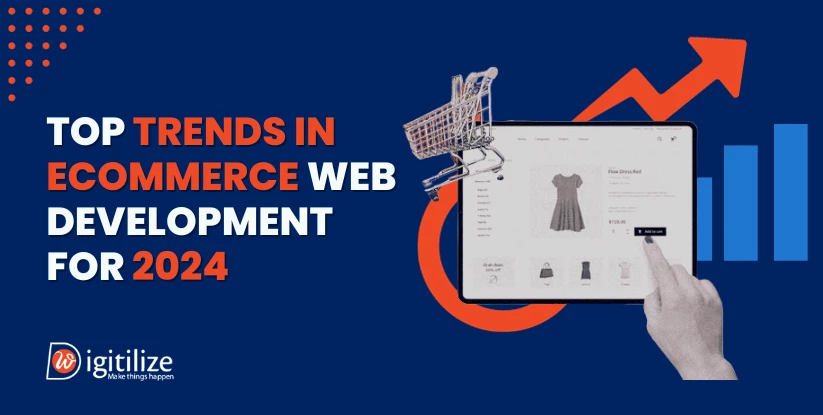Top Trends in Ecommerce Web Development for 2024

Introduction
The ecommerce world keeps changing fast. New tools and shifting user habits are shaping how online stores work. In 2024, ecommerce web development is going through big changes. Businesses need to keep up. Following the latest trends helps you improve the user experience, boost security, and increase sales. Staying updated is no longer optional—it’s a must. In this blog, we will explore the top ecommerce web development trends for 2024 and how they can help your online business thrive.Top E-commerce web development trends for 2024
1. Progressive Web Apps (PWAs)
Progressive Web Apps (PWAs) continue to dominate ecommerce web development. PWAs provide a seamless, app-like experience while running on a browser, ensuring fast loading times, offline access, and improved user engagement.Benefits of PWAs for Ecommerce:
- Faster load speeds and better performance
- Enhanced user experience across devices
- Improved SEO and search engine rankings
- Offline shopping capabilities
2. AI and Machine Learning Integration
Artificial intelligence (AI) and machine learning are revolutionizing ecommerce by personalizing the shopping experience. AI-powered chatbots, predictive analytics, and recommendation engines are becoming essential tools for businesses.AI Applications in Ecommerce:
- Personalized product recommendations
- Automated customer support with AI chatbots
- Smart inventory management
- Fraud detection and security enhancements
3. Voice Commerce Optimization
Voice search and smart assistants like Alexa and Google Assistant are gaining popularity in ecommerce. Businesses must optimize their ecommerce stores for voice commerce by using natural language processing (NLP) and conversational AI.
How to Optimize for Voice Commerce:
- Implement long-tail keywords and conversational phrases
- Optimize product descriptions for voice search
- Ensure mobile responsiveness and fast-loading pages
4. Headless Ecommerce
Headless ecommerce is a game-changer, separating the front-end and back-end of an ecommerce store, allowing greater flexibility and customization. This trend enables businesses to provide personalized experiences across multiple platforms.Advantages of Headless Ecommerce:
- Faster website performance
- Seamless integration with various third-party tools
- Better omnichannel experience
5. Augmented Reality (AR) and Virtual Reality (VR)
Augmented Reality (AR) and Virtual Reality (VR) are reshaping the ecommerce shopping experience. AR allows customers to visualize products in their environment before making a purchase, increasing confidence and reducing return rates.Use Cases of AR & VR in Ecommerce:
- Virtual try-ons for fashion and accessories
- 3D product previews for furniture and home decor
- Interactive shopping experiences

6. Blockchain for Secure Transactions
Blockchain technology is making ecommerce transactions more secure, transparent, and efficient. It eliminates intermediaries, reducing transaction costs and enhancing data security.Benefits of Blockchain in Ecommerce:
- Secure payment processing
- Transparent supply chain tracking
- Protection against fraudulent activities
7. Mobile-First Design and Optimization
With the increasing number of mobile shoppers, having a mobile-first ecommerce website is no longer an option—it’s a necessity. Responsive design, fast-loading pages, and intuitive navigation are key to retaining mobile users.Best Practices for Mobile-First Ecommerce:
- Implement a responsive web design
- Optimize images and content for faster load times
- Simplify the checkout process
8. Subscription-Based Ecommerce Models
Subscription-based ecommerce is gaining traction, offering customers a convenient way to receive products and services regularly. Businesses leveraging this model can improve customer retention and generate recurring revenue.Examples of Subscription-Based Ecommerce:
- Monthly beauty and wellness boxes
- Meal kit delivery services
- Online streaming and digital content services
9. Sustainable and Eco-Friendly Ecommerce Solutions
Sustainability is becoming a priority for consumers, and businesses are adopting eco-friendly ecommerce solutions to align with this growing demand.Strategies for Sustainable Ecommerce:
- Use biodegradable or recyclable packaging
- Implement carbon-neutral shipping options
- Partner with eco-conscious suppliers
10. Hyper-Personalization with Big Data
Big data is helping ecommerce businesses deliver hyper-personalized experiences by analyzing user behavior, preferences, and purchasing history.Ways to Implement Hyper-Personalization:
- AI-driven dynamic pricing
- Custom-tailored product recommendations
- Personalized email marketing campaigns
Conclusion
The ecommerce industry is changing fast. In 2024, staying ahead of trends gives your business a strong edge. Tools like PWAs, AI, voice commerce, and blockchain are reshaping online shopping. These technologies help you boost user experience, strengthen security, and get more sales.
If you’re looking for expert ecommerce web development services, visit DigitilizeWeb to transform your online store and stay ahead of the competition.
